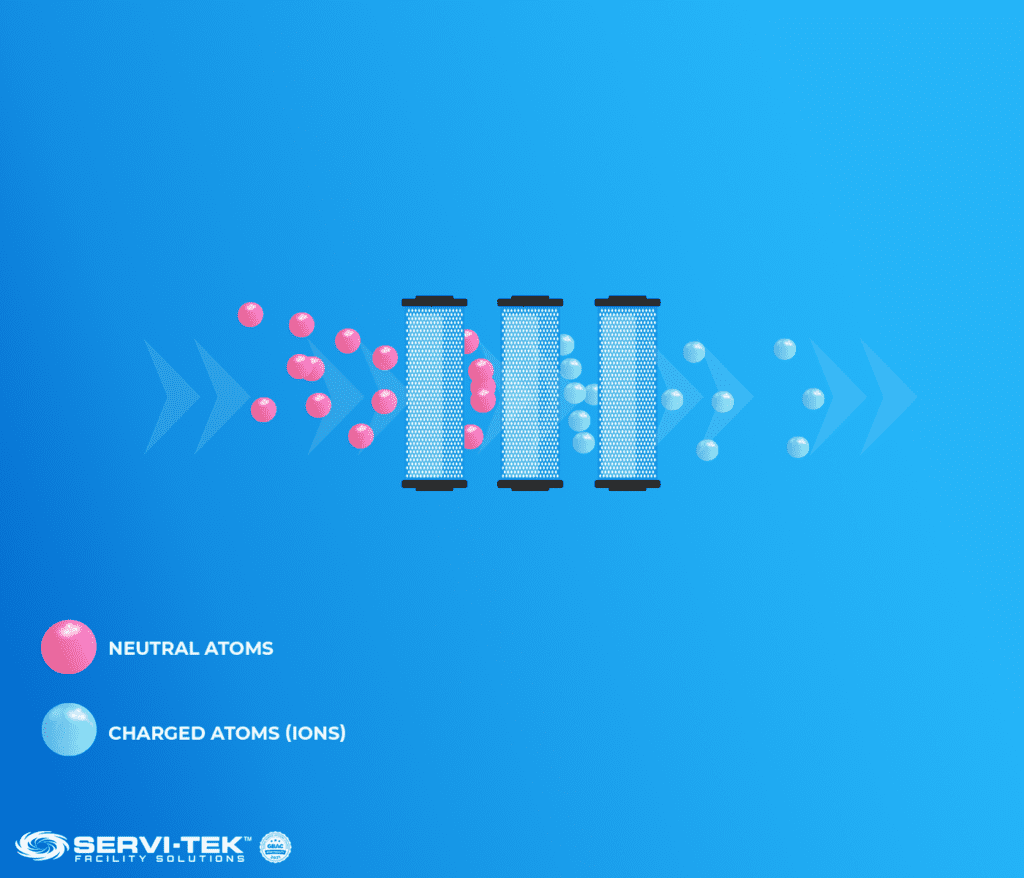Outline

In the first part of our Air Quality Series, we talked about the importance of indoor air quality, health-threatening pollutants, and solutions to prevent and combat them.
The post today goes in-depth on one of the best technologies you can benefit from when it comes to air purification.
Continue reading to learn, in non-technical terms (as the science behind is no easy task), how the Needle Bipolar Ionization technique can:
- save you money
- bring the fresh, mountain air indoors
- upgrade the performance of your current HVAC system
- and many more
What It Is
In its most simple definition, bipolar ionization work (also called needlepoint bi-polar ionization) involves techniques that improve indoor air quality (IAQ) by limiting harmful particles in the air.
It is a much-needed technology, as indoor air pollution levels are sometimes 2 to 5 times higher than outdoor levels, and can also reach 100 times higher in some cases.
Medically, needlepoint bi-polar ionization has been effectively used against COVID-19, norovirus, and the flu. Further, efforts to improve IAQ help remove bacteria, pollen, viruses, and mold, and can be used for pathogen control and particle reduction.
As a bonus, it also neutralizes volatile organic compounds, odors, and allergy-causing dander and it uses your existing HVAC system as the delivery method.
How It Works

Bipolar ionization (BPI) is a commercially available technology that generates a stream of positive and negative ions.
They are capable of capturing pollutants in the air, such as volatile organic compounds (VOCs), odors, and dangerous molecules.
When these ions disperse throughout a closed space, they seek out and form bonds with the particles present in the air.
This creates a snowball-like, effect in which the molecules begin to cluster together.
The bigger the cluster gets, the simpler it is for your device to remove it.
Needlepoint Bipolar Ionization safely and properly cleans the air within commercial, industrial, and residential buildings.
The ions produced also kill pathogens by depriving them of life-sustaining hydrogen.
Here are the main benefits of Bipolar Ionization:
- Health-threatening particles removal: the technology causes particles to clump together, allowing them to be captured by even a low-efficiency filter
- Control of pathogens: transmission of pathogens and mold spores is prevented, as they are destroyed
- Savings on energy: by purifying and recirculating indoor air, the HVAC system is not as needed and used, therefore you can save a lot of money on maintenance and bills
- Odor control: odors and similar substances are broken down and removed by the system
- Disease control: ionization is effective in managing and preventing diseases in closed spaces, as the microbes are filtered and removed
Recommendations For Best Ionization
The HVAC systems found in large buildings are important for ensuring good indoor air quality; therefore, maintaining the filters is critical
If your HVAC system is not set correctly or is inefficient, the bipolar ionization devices will not be able to work properly.
Because of the range and complexity of HVAC systems in large buildings, technical standards must be interpreted by trained professionals.
Another recommendation is to be careful which company and technology you choose.
For example, the EPA recommends working with a commercial services provider using a device that meets UL 2998 standard certification (Environmental Claim Validation Procedure (ECVP) for Zero Ozone Emissions from Air Cleaners).
Also, keep in mind that some air purifiers are designed to produce ozone. Since ozone can irritate the airways, these products are not recommended.
Is Bipolar Ionization A Vacuum Less Discharge Plasma?
You can think of ions as air scrubbers that are naturally present in the environment around us.
They are the ones to thank for the fresh air outside.
The ionization of air or gas creates plasma, therefore the system used for bipolar ionization is also known as verbiage.
In short, plasma is ionized air.
Because of their efficacy in removing bacteria, viruses, and other allergens, plasma purifiers were initially intended for hospitals.
They were also very huge, making them unsuitable for approachable use.
However, technology has advanced in recent years, and plasma air purifiers are now much smaller, and more efficient, making them convenient and practical.
Can This Ionization Technique Be Used To Create A Sun?
Nobody wants poor-quality indoor air.
Your lungs are in charge of getting fresh air into your body and eliminating waste gases and particulates at the same time.
It goes without saying that the more pollutants in the air you breathe, the harder it is for your lungs to expel them.
Poor air quality, whether indoors or out, will make it difficult for your lungs to work properly and bring plenty of negative consequences.
But how can we get fresh, mountain air from the polluted air filled with germs, viruses, odors, mold, and dust particles?
Some ions are naturally formed by energy from the sun, waves, and running water.
These ions help generate the clean air we enjoy outside.
We breathe on average 11,000 liters of air per day and around 7 or 8 liters of air per minute.
The sun plays a major part in ionizing the atmosphere and helping us inhale fresh air.
This is one of the reasons why people cherish days spent in nature. The ionization allows the air to clean itself, and our body and system feel the benefits.
Our daily routine, on the other hand, is very different: we spend most of our time indoors. As a result, the quality of indoor air has a major impact on our health and well-being.
In the indoor, enclosed space, unfortunately, ions may not exist at all.
Using bipolar ionization technology is like bringing the positive effects of the sun, running water, and other natural elements, indoors.
What Metal Is Used For Bipolar Ionization?
In the past, bipolar ionization technology could produce harmful byproducts such as ozone.
Modern technology, on the other hand, does not emit harmful levels of ozone or ultraviolet radiation.
Bipolar ion generators go much further in terms of environmental friendliness. They don’t use any harsh chemicals, heavy metals, or mercury-containing elements.
Needlepoint bipolar ionization started by using stainless steel needles to produce the ionized air.
However, the needles began to oxidize and fail due to the high voltage and water vapor current, and the ions were unable to emit as the tips corroded and turned dull.
Following, carbon fiber brushes were introduced to improve efficiency and durability, and are used to this day in modern ionization systems. The fibers are known for being long-lasting and efficient.
The carbon fiber brushes have an effective mechanical life of over 68,000 years. That’s more than 8 million cleaning cycles.
Other materials include gold, titanium, silver, or any other corrosion-resistant and conductive material.
Check with your service provider about the type of materials they use for the process. If it’s stainless steel, avoid the company at all costs, as your health and money are on the line.
Common Needle Point Bipolar Ionization Jargon To Understand
There is a lot of science and engineering behind clean indoor air.
This mini-guide will help you with the most important terms you should know to better understand the process:
Ion
Air is a mixture of gases including nitrogen, oxygen, carbon dioxide, water vapors, and other trace gases. Under certain circumstances, these gas molecules become charged and are referred to as air ions.
So, in short, an ion is a positively or negatively charged molecule.
Air ionizer
An air ionizer is a device that ionizes or electrically charges air molecules by using high voltage. Purifying the air of particles, pollutants, and allergens is one of the many uses of air ionizers.
Electrons
The electron is a negatively charged molecule. In contrast, remember that ions are molecules that have a net electric charge (positive or negative) as a result of the loss or gain of one or more electrons.
If an electron is gained, the molecule becomes negatively charged. If an electron is lost, it becomes positively charged.
Plasma
Plasma is ionized gas. It is one of the four fundamental states of matter, but can also be created artificially, through BPI technology for example.
Ozone
Ozone is a naturally occurring gas, yet dangerous for human health. Why is it mentioned here?
Because some bipolar ionizers produce this gas indirectly through the ionization process. However, there are accredited and proven ozone-free technologies and manufacturers.
MERV
The Minimum Efficiency Reporting Value (MERV) is a scale that ranges from 1 to 20.
It assesses a filter’s ability to collect particles of different sizes.
The higher the scale, the better the filtration and air quality are.
Electrode
An electrode is an electrical conductor through which electricity enters or leaves an object or substance. It is used in NBPI systems to ionize the air.
Methods Of Bipolar Ionization
The most notable bipolar ionization technologies are Corona Discharge and Needlepoint Bipolar Ionization.
Corona Discharge
Simply put, the corona discharge technology produces ions by using a pair of electrical current conductors.
The disadvantage of corona discharge ionization is the possible formation of ozone, which can damage human respiratory tissues.
Needlepoint Bipolar Ionization (NBPI)
Needlepoint Bipolar Ionization, unlike corona discharge systems, does not directly ionize oxygen.
The technology uses a pair of electrodes, one positive and one negative, to generate a plasma field (high-voltage electric field) that extracts electrons from air molecules.
Advantages And Disadvantages Of Bipolar Ionization

Since this is a relatively new technology on the market, there are many skeptics about it.
Here is all you need to know if you consider using bipolar ionization in your indoor spaces:
Adaptability
There are several uses for this technology in both commercial and residential environments. Malls, education, entertainment, health care, hospitality, offices, and transportation are only a few of the areas that have already benefited from cleaner, safer air.
No ozone
This is a debated topic. Ozone is a lung irritant dangerous to human health.
In the past, bipolar ionization technology had a reputation for generating ozone, and to this day, unfortunately, there can still be accredited devices to do so.
However, to find the safest and most powerful way to ionize the air, look for the UL 2998 certification. It is the ASHRAE standard for ozone-free emissions, and it guarantees your and your tenants’ safety.
No ongoing maintenance.
The only auto-cleaning air purification system that ensures optimum long-term efficiency is manufactured by Global Plasma Solutions (GPS).
On the other hand, some manufacturers use improper materials in their units.
Talk to your service provider, to a specialist, and read the small print
Remember, metal needles, regardless of form, deteriorate over time. Carbon fiber, used by Global Plasma Solutions, does not deteriorate mechanically or chemically.
Affordability end efficiency
Low product and installation costs contribute to a complete indoor air quality solution that is both affordable and effective.
The efficiency of HVAC filters is improved by this technology.
Also, lower-rated MERV (Minimum Efficiency Reporting Value) filters perform like the top-rated ones through the bipolar ionization unit. Same cost, increased efficiency.
Ecological and nature-oriented
NPBI reduces a building’s carbon footprint in addition to making the air cleaner to breathe. Reduced outdoor air intake results in up to 30% energy savings, allowing HVAC systems to work more effectively.
Disciplines Where Ionization Is Used
Ionization is mainly used in genome sequencing, cosmochemistry, medical studies, organic chemistry, geophysical sciences, nuclear physics, and the list goes on.
It is a naturally occurring phenomenon that has many applications, not just the one of fresh, clean air.
In chemistry, for example, ionization commonly occurs as a liquid solution.
Because of the constant absorption of cosmic rays from space and ultraviolet radiation from the Sun, the Earth’s atmosphere has a certain degree of ionization as well.
Ionization can be seen in everyday life, such as in a fluorescent lamp or radiation therapy.
Ionization is a common process that occurs around us at all times, in different forms, and with different purposes.
Electrostatic Atomization Uses A Corona Discharge
Electrostatic atomization is a method of disinfection that uses an electrostatic applicator to spray a negatively charged cleaning solution on any type of surface.
These molecules or atoms of the solution, due to their charge, stick to the surface they are sprayed on.
It is a very effective disinfection method due to the unique way it’s applied, and it can reach any corner and surface normally missed.
A corona discharge is an electrical discharge caused by the ionization of particles, either be it fluids or gases.
In short, ionization is the action and corona discharge is the result.
There are a variety of commercial and industrial uses for corona discharge:
- Pool water sanitization
- In air-conditioning systems, scrubbing pollutants from the air
- Air ionizers
- Removal of various pollutants
Bipolar Ionization Ionizes Molecules By Electrical Discharges

The process of air ionization uses electric currents to convert neutral atoms in the air into charged atoms (ions) that interact with the environment to increase indoor air quality.
Global Plasma Solution (GPS) is a top-accredited company that manufactures a patented NPBI technology.
This technology creates a plasma or electromagnetic field with a high concentration of positively and negatively charged ions using an electronic charge.
Global Plasma Solutions has spent the last 15 years developing its NPBI technology to achieve high levels of indoor bipolar air ionization without generating harmful byproducts like ozone.
The efficiency Of An Ionization Method Can Be Checked By Fast GC
Gas chromatography (GC) is a commonly used analysis.
It helps to classify and measure the materials that make up a sample or discover pollutants that affect product quality.
How does it work?
The gases about to be tested are passed through a column that has been covered with a special coating.
This coating attracts the various components of the sample to different degrees, and their levels are tested and transmitted for interpretation.
Gas chromatography is a great analysis for quality control and troubleshooting and has a wide range of applications.
Existence And Non-Existence Of Stable Needlepoint Bipolar Ionization State
The NBPI performance depends on many factors.
First, its accreditations and certifications. Check the labels and talk to a specialist to make sure that the technology is safe and tested.
An inefficient device will not only give you the false impression that you are safe, when in fact, you’re at risk, but it can also emit even more dangerous gases for human health.
Second, you need a leading commercial facility engineering services company to install it correctly, and to help you assess the performance of your current ventilation system, as the two are interconnected.
And especially amidst a Covid-19 pandemic, you must focus your efforts on finding the best service provider for your needs in the US.
LOOKING TO BREATHE FRESH AND CLEAN AIR?
Servi-Tek Facility Solutions is an established engineering and facility maintenance service provider that creates customized solutions that contribute to commercial buildings’ overall performance and appearance.
We continue expanding our expertise by employing many of the latest technologies available in the industry.
We have partnered with Global Plasma Solutions (GPS) to offer professional installation and maintenance services using needlepoint bipolar ionization systems.
Since 2006, we have provided top janitorial and engineering solutions for various commercial and industrial clients.
Call us at (866) 454-6185 or use our online form to schedule a call and find out more.




